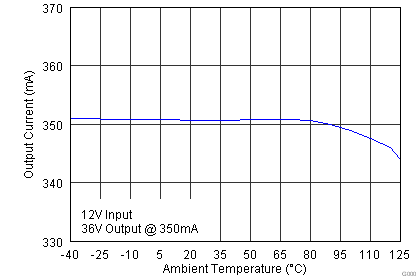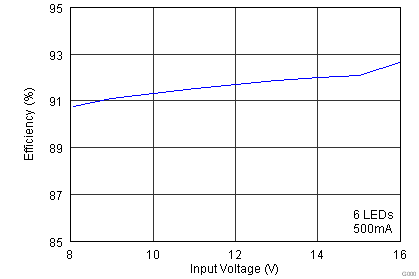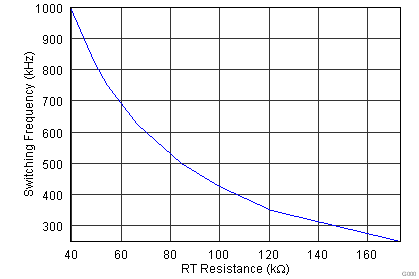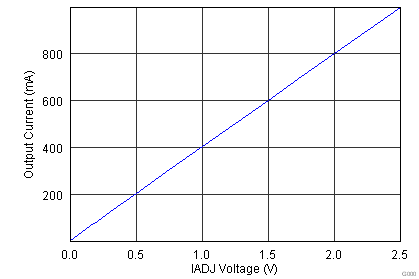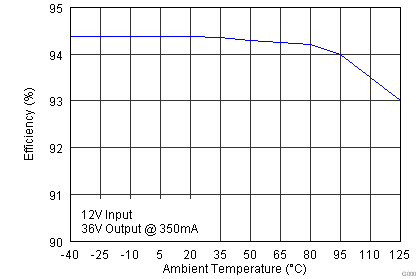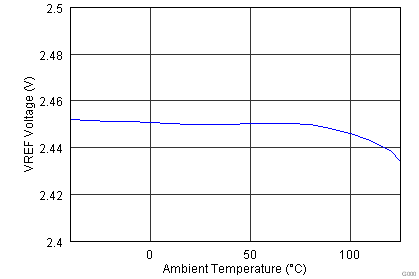ZHCSAO9A December 2012 – September 2015 TPS92690
PRODUCTION DATA.
- 1 特性
- 2 应用
- 3 说明
- 4 修订历史记录
- 5 Pin Configuration and Functions
- 6 Specifications
-
7 Detailed Description
- 7.1 Overview
- 7.2 Functional Block Diagram
- 7.3
Feature Description
- 7.3.1 Current Regulators
- 7.3.2 Peak Current Mode Control
- 7.3.3 Switching Frequency and Synchronization
- 7.3.4 Current Sense and Current Limit
- 7.3.5 Average LED Current
- 7.3.6 Precision Reference (VREF)
- 7.3.7 Low-Level Analog Dimming
- 7.3.8 Soft-Start and Shutdown
- 7.3.9 VCC Regulator and Start-Up
- 7.3.10 Overvoltage Protection (OVP)
- 7.3.11 Input Undervoltage Lockout (UVLO)
- 7.3.12 PWM Dimming
- 7.3.13 Control Loop Compensation
- 7.3.14 Thermal Shutdown
- 7.4 Device Functional Modes
-
8 Application and Implementation
- 8.1 Application Information
- 8.2
Typical Applications
- 8.2.1
Basic Topology Schematics
- 8.2.1.1 Design Requirements
- 8.2.1.2
Detailed Design Procedure
- 8.2.1.2.1 Operating Point
- 8.2.1.2.2 Switching Frequency
- 8.2.1.2.3 Average LED Current
- 8.2.1.2.4 Inductor Ripple Current
- 8.2.1.2.5 Output Capacitance
- 8.2.1.2.6 Peak Current Limit
- 8.2.1.2.7 Loop Compensation
- 8.2.1.2.8 Input Capacitance
- 8.2.1.2.9 NFET
- 8.2.1.2.10 Diode
- 8.2.1.2.11 Input UVLO
- 8.2.1.2.12 Output OVLO
- 8.2.1.3 Application Curve
- 8.2.2
Simplified Application
- 8.2.2.1 Design Requirements
- 8.2.2.2
Detailed Design Procedure
- 8.2.2.2.1 Operating Point
- 8.2.2.2.2 Switching Frequency
- 8.2.2.2.3 Average LED Current
- 8.2.2.2.4 Inductor Ripple Current
- 8.2.2.2.5 LED Ripple Current
- 8.2.2.2.6 Peak Current Limit
- 8.2.2.2.7 Loop Compensation
- 8.2.2.2.8 Input Capacitance
- 8.2.2.2.9 NFET
- 8.2.2.2.10 Diode
- 8.2.2.2.11 Output OVLO
- 8.2.2.2.12 Input UVLO
- 8.2.2.2.13 Soft-Start
- 8.2.2.2.14 PWM Dimming Method
- 8.2.2.2.15 Analog Dimming Method
- 8.2.1
Basic Topology Schematics
- 9 Power Supply Recommendations
- 10Layout
- 11器件和文档支持
- 12机械、封装和可订购信息
6 Specifications
6.1 Absolute Maximum Ratings
All voltages are with respect to GND, –40°C < TJ = TA< 125°C, all currents are positive into and negative out of the specified terminal (unless otherwise noted) (1)| MIN | MAX | UNIT | ||
|---|---|---|---|---|
| Supply voltage | VIN | –0.3 | 76 | V |
| Input voltage | nDIM, OVP | –0.3 | 76 | V |
| IS(2) | –0.3 | 76 | ||
| CSP, IADJ, SS/SD, ILIM | –0.3 | 6 | ||
| Output voltage | VCC, GATE(3) | –0.3 | 14 | V |
| COMP, RT, VREF | –0.3 | 6 | ||
| Continuous input current | IS | –1 | mA | |
| GATE | –1 | 1 | ||
| SYNC | 1 | |||
| Output current | VREF | –1 | mA | |
| Operating junction temperature, TJ(4) | 150 | °C | ||
| Storage temperature, Tstg | –65 | 150 | °C | |
(1) Stresses beyond those listed under Absolute Maximum Ratings may cause permanent damage to the device. These are stress ratings only, which do not imply functional operation of the device at these or any other conditions beyond those indicated under Recommended Operating Conditions. Exposure to absolute-maximum-rated conditions for extended periods may affect device reliability.
(2) The IS pin can sustain –2 V for 100 ns without damage.
(3) the GATE pin can sustain –2.5 V for 100 ns. The VCC pin can sustain –2.5 V for 100 ns.
(4) Maximum junction temperature is internally limited.
6.2 ESD Ratings
| VALUE | UNIT | ||||
|---|---|---|---|---|---|
| V(ESD) | Electrostatic discharge | Human body model (HBM), per ANSI/ESDA/JEDEC JS-001, all pins(1) | ±2000 | V | |
| Charged device model (CDM), per JEDEC specification JESD22-C101, all pins(2) | ±1250 | ||||
(1) JEDEC document JEP155 states that 500-V HBM allows safe manufacturing with a standard ESD control process.
(2) JEDEC document JEP157 states that 250-V CDM allows safe manufacturing with a standard ESD control process.
6.3 Recommended Operating Conditions
over operating free-air temperature range (unless otherwise noted)| MIN | NOM | MAX | UNIT | ||
|---|---|---|---|---|---|
| VIN | Input voltage | 4.5 | 12 | 75 | V |
| TJ | Operating junction temperature | –40 | 25 | 125 | °C |
| VIADJ(max) | Maximum operating IADJ voltage | 0 | 5 | V | |
6.4 Thermal Information
| THERMAL METRIC(1) | TPS92690 | UNIT | |
|---|---|---|---|
| PWP (TSSOP) | |||
| 16 PINS | |||
| RθJA | Junction-to-ambient thermal resistance | 39.1 | °C/W |
| RθJC(top) | Junction-to-case (top) thermal resistance | 23.8 | °C/W |
| RθJB | Junction-to-board thermal resistance | 17.5 | °C/W |
| ψJT | Junction-to-top characterization parameter | 0.6 | °C/W |
| ψJB | Junction-to-board characterization parameter | 17.2 | °C/W |
| RθJC(bot) | Junction-to-case (bottom) thermal resistance | 1.9 | °C/W |
(1) For more information about traditional and new thermal metrics, see the Semiconductor and IC Package Thermal Metrics application report, SPRA953.
6.5 Electrical Characteristics
–40°C < TJ = TA < 125°C, VIN = 14 V (unless otherwise noted)| PARAMETER | TEST CONDITIONS | MIN | TYP | MAX | UNIT | |
|---|---|---|---|---|---|---|
| STARTUP REGULATOR (VCC) | ||||||
| VCCREG | VCC regulation voltage | ICC = 0 mA | 6.35 | 6.9 | 7.45 | V |
| ICCLIM | VCC current limit | VVCC = 0 V | –20 | –30 | mA | |
| IQ | Quiescent current | 2 | 3 | mA | ||
| ISD | Shutdown current | VSS/SD = 0 V | 45 | 65 | μA | |
| VCCUV | VCC UVLO threshold | VVCC rising | 4.1 | 4.50 | V | |
| VVCC falling | 3.61 | 4.01 | ||||
| VCCHYS | VCC UVLO hysteresis | 83 | mV | |||
| REFERENCE VOLTAGE OUTPUT | ||||||
| VREF | Reference voltage | No load | 2.4 | 2.45 | 2.5 | V |
| ERROR AMPLIFIER | ||||||
| CSP input bias current | –0.6 | 0 | 0.6 | μA | ||
| COMP sink current | 17.1 | 28.5 | 39.9 | μA | ||
| COMP source current | VIADJ = 5 V | –12.6 | –16.8 | –21 | μA | |
| gM | Transconductance | VIADJ = 1 V, 0 V ≤ VCSP ≤ 0.8 V | 33 | μA/V | ||
| Transconductance bandwidth | –6dB | 1 | MHz | |||
| IADJ pin input impedance | 1 | MΩ | ||||
| VCSP | Error amplifier reference voltage | Precise value implied in offset | VIADJ/10 | V | ||
| Error amplifier input offset voltage | VVCC = 4.5 V, 1 V ≤ VCOMP ≤ 1.4 V, TA = 25°C | –1.5 | 0 | 1.5 | mV | |
| VVCC > 6 V, 1 V ≤ VCOMP ≤ 3 V, VIADJ ≤ 1.25 V, TA = 25°C | –1.8 | 0 | 1.8 | |||
| VVCC > 6 V, 1 V ≤ VCOMP ≤3 V, VIADJ > 1.25 V, TA = 25°C (% of ) | –1.44 | 0 | 1.44 | VCSP% | ||
| PWM COMPARATOR AND SLOPE COMPENSATION | ||||||
| DMAX | Maximum duty cycle | Internal oscillator only | 90% | 94.4% | ||
| IS to PWM offset voltage | No slope added | 950 | 1100 | 1250 | mV | |
| D = DMAX (maximum slope added) | 125 | |||||
| IOFF | IS source current | No slope added | –11.9 | μA | ||
| IOFF + ISL | D = DMAX (maximum slope added) | –60 | μA | |||
| CURRENT LIMIT | ||||||
| ILIM delay to output | 60 | 100 | ns | |||
| tON(min) | Leading edge blanking time | 200 | 300 | ns | ||
| Current limit off-timer | 38 | μs | ||||
| ILIM offset voltage | D = 50% | –19 | –5.6 | 5 | mV | |
| LOW POWER SHUTDOWN AND SOFTSTART | ||||||
| VSD | Shutdown threshold voltage | VSS/SD falling | 30 | 86 | mV | |
| VSDH | Shutdown hysteresis | 24 | mV | |||
| ISS | SS/SD current source | VSS/SD > (VSD + VSDH) | –10.8 | μA | ||
| VSS/SD < VSD | –1.1 | μA | ||||
| OSCILLATOR AND EXTERNAL SYNCHRONIZATION | ||||||
| ƒSW | Switching frequency | RRT = 121 kΩ | 312 | 350 | 389 | kHz |
| RRT = 100 kΩ | 372 | 418 | 464 | |||
| RRT = 84.5 kΩ | 436 | 490 | 544 | |||
| SYNC threshold voltage (falling edge triggers on-time) | Rising | 2.05 | 2.36 | V | ||
| Falling | 0.95 | 1.31 | ||||
| SYNC Clamp Voltage | Positive | 6.2 | V | |||
| Negative | –0.5 | |||||
| OVERVOLTAGE PROTECTION | ||||||
| OVP OVLO threshold | Rising | 1.23 | 1.282 | V | ||
| Falling | 1.144 | 1.19 | ||||
| OVP hysteresis source current | OVP active (high) | –14 | –21.5 | –28 | μA | |
| PWM DIMMING INPUT AND UVLO | ||||||
| nDIM/UVLO threshold | Rising | 1.23 | 1.285 | V | ||
| Falling | 1.14 | 1.19 | ||||
| nDIM hysteresis current | –14 | –21.6 | –28 | μA | ||
| GATE DRIVER | ||||||
| GATE sourcing resistance | GATE = High | 2.4 | 6 | Ω | ||
| GATE sinking resistance | GATE = Low | 1 | 5 | Ω | ||
| Peak GATE current | Source | –0.47 | A | |||
| Sink | 1.1 | A | ||||
| THERMAL SHUTDOWN | ||||||
| TSD | Thermal shutdown temperature | 175 | °C | |||
| TSD(hys) | Thermal shutdown hysteresis | 25 | °C | |||
6.6 Typical Characteristics
Unless otherwise noted, –40°C ≤ TA = TJ≤ 125°C, VVIN = 14 V, CBYP = 2.2 µF, CCOMP = 0.1 µF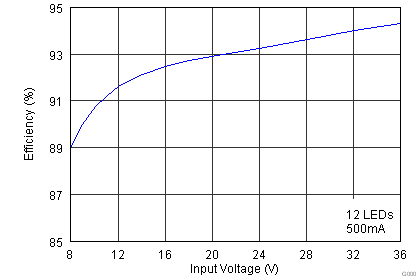
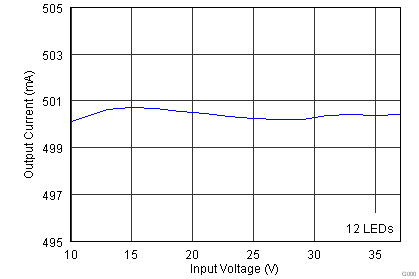
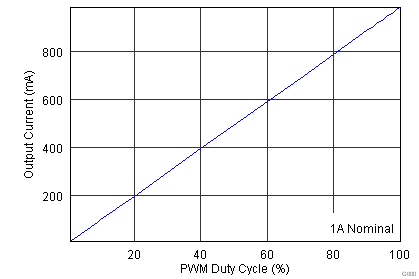
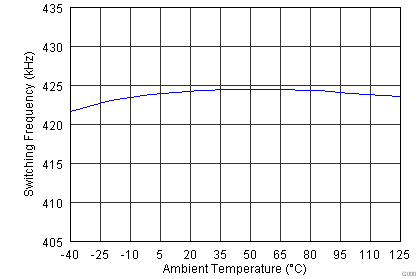
(RT = 100 kΩ)
